How to choose a circuit breaker calculation. Selection of circuit breakers
- How to choose a circuit breaker?
- Determination of the number of poles of the machine
- Rated voltage of the machine
- Selection of a circuit breaker for load current
- Breaking capacity
- Circuit Breaker Selectivity
- Thermal load of several machines installed in a row
- Circuit Breaker Selection Criteria
- one#. Number of poles
- 2 #. Rated voltage
- 3 #. Maximum operating current
- four#. Breaking capacity
Current calculation short circuit necessary for the correct selection and detuning of protective equipment. A short-circuit current occurs when the current-carrying parts of the phases are connected to each other or to a grounded electrical receiver in circuits with a dead-earthed neutral and zero wire . Its value, A, can be determined by the formula
where u f - phase voltage nets, B;
Z p - loop resistance phase zero, Ohm, 
R is the active resistance of one wire of a short circuit, Ohm;
X - inductive resistance, calculated by the inductive resistivity equal to 0.6 Ohm / km;
Z t - the impedance of the phase winding of the transformer on the side low voltage Ohm

where UH , IH - rated voltage and current of the transformer;
UK % - transformer short circuit voltage,% of nominal.
The values of UH , l N and U to % for the corresponding transformer are given in chapter 5.
Selection electrical apparatus carried out by its functional purpose, by the type of voltage and current, -> the magnitude of the power.
It should be borne in mind the current trend, which is that when choosing between fuses and circuit breakers, the latter is preferred because of their greater reliability, better protection from non-phase modes, versatility, etc.
The choice of apparatus for voltage is in accordance with the nominal voltage specified in the passport of the apparatus, and its kind (alternating, constant) rated voltage supply network. When choosing a device by current, it should be noted that its rated current should not be less than the operating current of the installation.
Selection of circuit breakers
Circuit breakers are selected primarily by nominal values voltage and current. Then, the setpoint currents of the thermal and electromagnetic releases are determined.
The heat release of the automat protects the electrical installation from prolonged overcurrent. Setting current thermal release is assumed to be 15-20% more than the operating current:

where 1 P is the operating current of the electrical installation, A.
The electromagnetic release of the machine protects the electrical installation from short circuits. Setting current electromagnetic release is determined from the following considerations: the machine should not operate from the starting currents of the electrical motor I start . dv ., and the opening current of the electromagnetic release I EMR is chosen to be a multiple of the operation current of the thermal release:

where K = 4.5-10 is the ratio of the current response of the electromagnetic scavenger.
The selected circuit breaker is checked for sensitivity and breaking capacity. Automatic machines with a rated current of up to 100 A should operate under the condition

where I OKK.Z. - single-phase short circuit current.
The sensitivity of an automaton having only a thermal release is determined by the ratio:
How to choose a circuit breaker?
You can not buy a machine with a damaged case, with visible cracks, chips. It is also impossible to use machines with more than the rated current rating. First of all, the circuit breaker is selected based on the characteristics of your wiring and loads.
How to choose a circuit breaker
Automatic machines should be purchased in special stores and well-known manufacturers of circuit breakers. The cost of such machines is certainly higher, but it will go to the background if it concerns your security. The choice of circuit breakers carried out by such criteria as;
- the number of poles of the machine;
- long operating voltage ;
- maximum permissible operating current of the switch;
- breaking capacity;
- selectivity of the machine.
Determination of the number of poles of the machine
The choice of the number of poles of an automaton depends on the type of electrical network. With single phase network the number of poles can be 1 or 2, i.e. the automaton can be single-pole or double-pole.
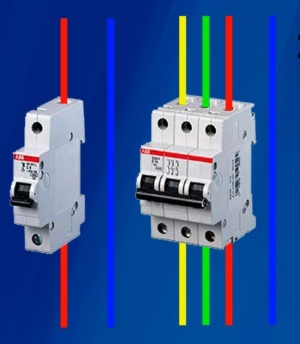
Connection of single-pole and three-pole circuit breaker
In everyday life, with a single-phase network at the input and for individual machines, single-pole structures are used. Bipolar machines can be used on input. In this case, the probability of operation of the two-pole automaton is doubled, in three phase networks use automata on three or four poles.
Rated voltage of the machine
The plastic case of the machine contains information about its characteristics and its operating voltage, which should be Unom ≥ U network equal to or greater than the line voltage.
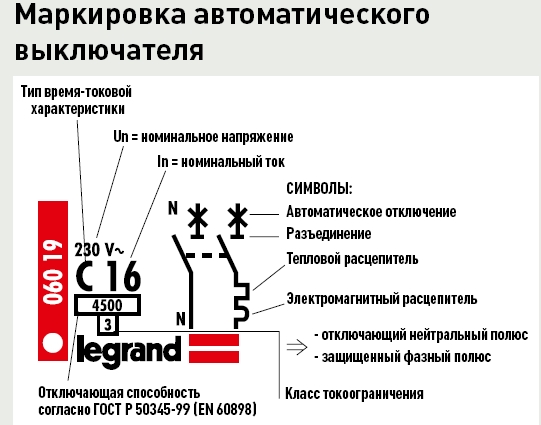
The main characteristics of the circuit breaker are marked on its case.
Selection of a circuit breaker for load current
To protect the wiring from overheating under high load, the following conditions should be taken into account:
- Current consumed electric circuit must not exceed the rated current of the automaton, while the rated current of the automaton must also not be greater than the rated rated current for this section of the wiring harness.
Iel where, Iel - rated load current,
Inom - rated current of the machine,
Iprov - estimated current wiring.
- The overcurrent of the automaton overload must be 1.45 times less than the maximum value of the wiring current. I pereg
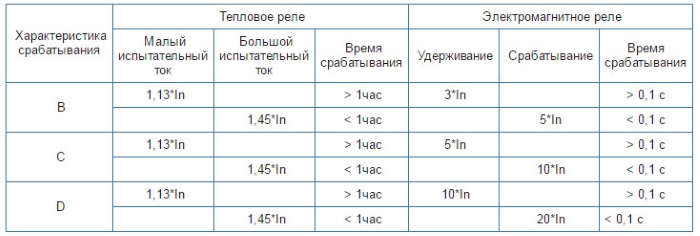
The table shows that the machine will turn off when overloaded to 13% of the rated current after a time equal to or greater than 1 hour. If the load reaches 45% of the rated current, the thermal protection of the machine will disconnect the load in less than one hour.
For electromagnetic protection of a type B machine with a triple overload, the response time will be 0.1 seconds or more, and with a fivefold overload, the protection will operate in less than 0.1 second.
Breaking capacity
This characteristic takes into account the ability of the machine to disconnect the contacts without sticking from short-circuit currents. These values of currents to. H. indicated on the switch housing.
It is better to choose machines with a guaranteed ability to switch off at currents to. H. equal to 3 - 4.5 kiloampere. The cost here is not looking - it's still your safety.
Circuit Breaker Selectivity
The selectivity value of the circuit breaker shows the ability of the circuit breaker to disconnect only those parts of the electrical circuit where a short circuit or overload has occurred. In order for the machine to have good selectivity, you need to make the right choice according to the parameters and class of the machine.
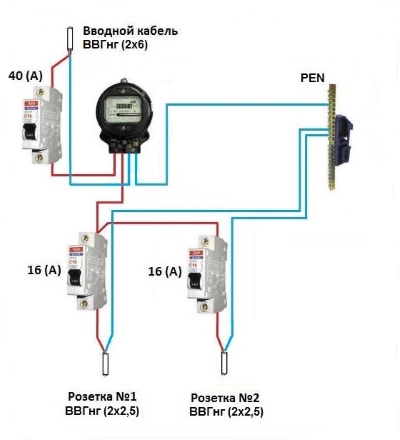
An example of the selectivity of circuit breakers
For good selectivity, the input automat should have a value of the rated current greater than the automata in the groups, but not exceed the maximum current of the electrical wiring. In groups, automata are selected according to the load current of this group. That is, in the event of a short circuit in the kitchen, the automatic socket kitchen panel will turn off, and not the lighting.
Thermal load of several machines installed in a row
When the circuit breakers are located in the electrical panel in a row, the temperature of the automata will increase and the nominal current of the automaton will decrease by the correction factor K of table 2.
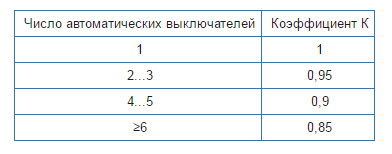
Table 3 shows the dependence of the rated current on the external temperature, which must also be considered when choosing a circuit breaker.
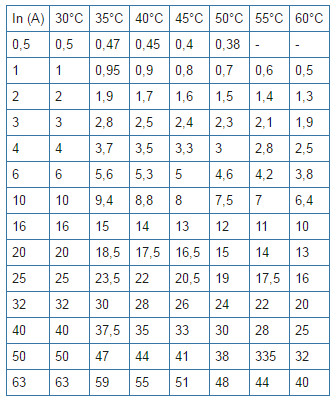

In the past, electrical plugs, usually ceramics, were used to protect electrical wiring and electrical equipment in everyday life from such abnormal modes of operation as overload or short circuit. The design of these devices is quite simple.
The disadvantage of these devices is that when the fuse blows, no one was concerned with the choice of a fusible link. Later, the traffic jam could not work at the right time, which was not rarely the cause of many fires.
At the present time, automatic circuit breakers (AB) have come to replace old traffic jams, which have many advantages and are more reliable in operation than traffic jams. Structurally, the AB is a module with two input / output contacts and a power button (single-pole automat).
The working mechanism of the circuit breaker is in a closed plastic case. In the back of the machine has a special latch, thanks to which it can be securely fixed to the DIN-rail when connecting to the electrical panel .
The selection of circuit breakers is a demanding task that needs to be taken seriously. In the event of an emergency, a correctly selected machine is a guarantee of protection not only of your equipment, but also of your life.
A circuit breaker is a switching device designed to automatically open an electrical circuit at the time of occurrence of short circuits or overloads.
In the diagrams are denoted by the letters AB or QF (European standard).
Circuit Breaker Selection Criteria
The main indicators that are referenced when choosing automata are:
- number of poles;
- Rated voltage;
- maximum operating current;
- breaking capacity (short circuit current).
one#. Number of poles
The number of poles of the automaton is determined from the number of phases of the network. For installation in a single-phase network use single-pole or two-pole. For three-phase network apply three-and four-pole (network system grounding neutral TN-S). In residential sectors, single or double pole machines are commonly used.
2 #. Rated voltage
The nominal voltage of the machine is the voltage for which the machine itself is designed. Regardless of the installation location, the voltage of the machine must be equal to or greater than the nominal mains voltage:
3 #. Maximum operating current
Maximum operating current. The choice of automatic machines for the maximum operating current is that the rated current of the machine (the rated current of the release) is greater than or equal to the maximum operating (rated) current that can continuously pass through the protected section of the circuit, taking into account possible overloads:
To find out the maximum operating current for the network section (for example, for an apartment) you need to find the total power. To do this, we summarize the power of all the devices that will be connected through this machine (refrigerator, TV, St.-oven, etc.). The amount of current from the received power can be found in two ways: by comparison or by the formula.
For a 220 V network with a load of 1 kW, the current is 5 A. In a network with a voltage of 380 V, the current value for 1 kW of power is 3 A. Using this mapping option, you can find the current through the known power. For example, the total power in the apartment turned out to be 4.6 kW, while the current is about 23 A. To find the current more accurately, you can use the well-known formula:
For household appliances.
four#. Breaking capacity
Breaking capacity. The choice of the automaton by the rated breaking current is reduced to ensure that the current which the circuit breaker is capable of disconnecting is greater than the short-circuit current at the installation point of the device: The rated breaking current is the largest short-circuit current. which the machine is able to turn off at rated voltage.
How to choose a circuit breaker?